Electric Revolution Skills Hub Product Design
I led the product design for the Electric Revolution Skills Hub, a national platform addressing the UK’s critical skills shortage in Power Electronics, Machines, and Drives (PEMD). Working in collaboration with Coventry University and UKRI’s £80 million ‘Driving the Electric Revolution’ challenge, I designed the multi-sided marketplace that connects learners, employers, and training providers across the electrification sector.
The platform launched with major UK universities and organisations including Newcastle, Queen’s, Cardiff, Leeds, Manchester, IET, UKRI, and BCMIO, establishing itself as the definitive “go-to place” for electrification careers and skills development.
Key Outcomes:
- Launched with major UK universities and national organisations as founding partners
- Platform now hosts hundreds of jobs and training courses
- Established as the national standard-setter through the PEMD Body of Knowledge
- Created scalable design framework supporting future monetisation strategies
- Delivered comprehensive design system enabling seamless team transition
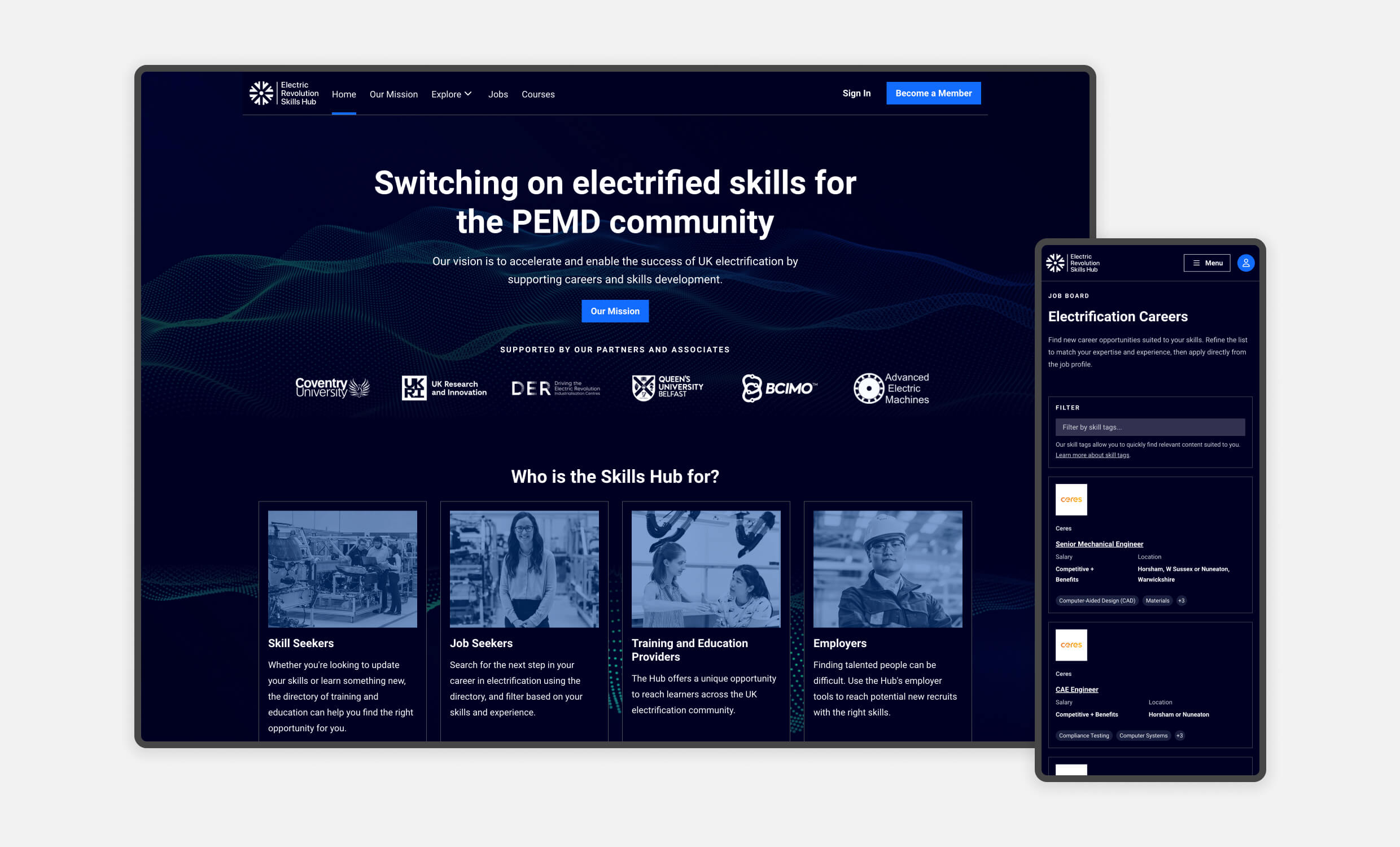
My Role & Responsibilities
As Lead Product Designer embedded within Coventry University’s team, I was responsible for transforming a national policy initiative into a functioning digital platform within a compressed 4-5 month timeline. Working directly with university stakeholders and UKRI representatives, my responsibilities encompassed the complete design process from strategic workshops through to launch and team transition.
My key contributions included facilitating discovery workshops to identify platform requirements, conducting competitive research across job boards and marketplace platforms, designing user journeys for multiple interconnected user types, creating wireframes and UI designs, developing a comprehensive design system, leading QA processes through development sprints, and presenting design decisions at the national launch event.
The Challenge
The UK faces a critical skills shortage threatening its Net Zero 2050 commitments. With 75% of manufacturers citing skills shortages as their biggest barrier to growth and an estimated £21 million daily cost from unfulfilled manufacturing vacancies, the electrification sector needed urgent intervention.
The ‘Driving the Electric Revolution’ challenge allocated £80 million to build UK PEMD capabilities, but only £6 million was dedicated to skills development. Within this constraint, Coventry University won the mandate to create a national skills hub that would function as the central marketplace for electrification careers, training, and talent.
Critical Design Challenges:
- Multi-sided marketplace complexity: Designing for three distinct user groups (learners, employers, training providers) with interconnected but different needs
- National scale with immediate impact: Creating a platform robust enough to serve as the UK’s definitive skills resource whilst launching within months
- Long-term strategic positioning: Designing not just for launch but for future monetisation and sustainable growth
- Authority and credibility: Establishing visual and functional credibility to compete with established platforms like Indeed whilst serving a specialised technical community
Discovery & Strategic Foundation
I led collaborative workshops with Coventry University stakeholders to understand the complex ecosystem we were designing for. These sessions revealed the fundamental challenge: the platform needed to simultaneously serve individual job seekers, major corporations planning decade-long workforce strategies, and universities developing new curricula.
The strategic breakthrough came from recognising this wasn’t just about listing jobs and courses—we were designing the foundational infrastructure for an entire industry’s talent pipeline. The platform needed to establish the PEMD Body of Knowledge (PEMDBoK) as the definitive skills standard whilst creating sustainable revenue streams for long-term viability.
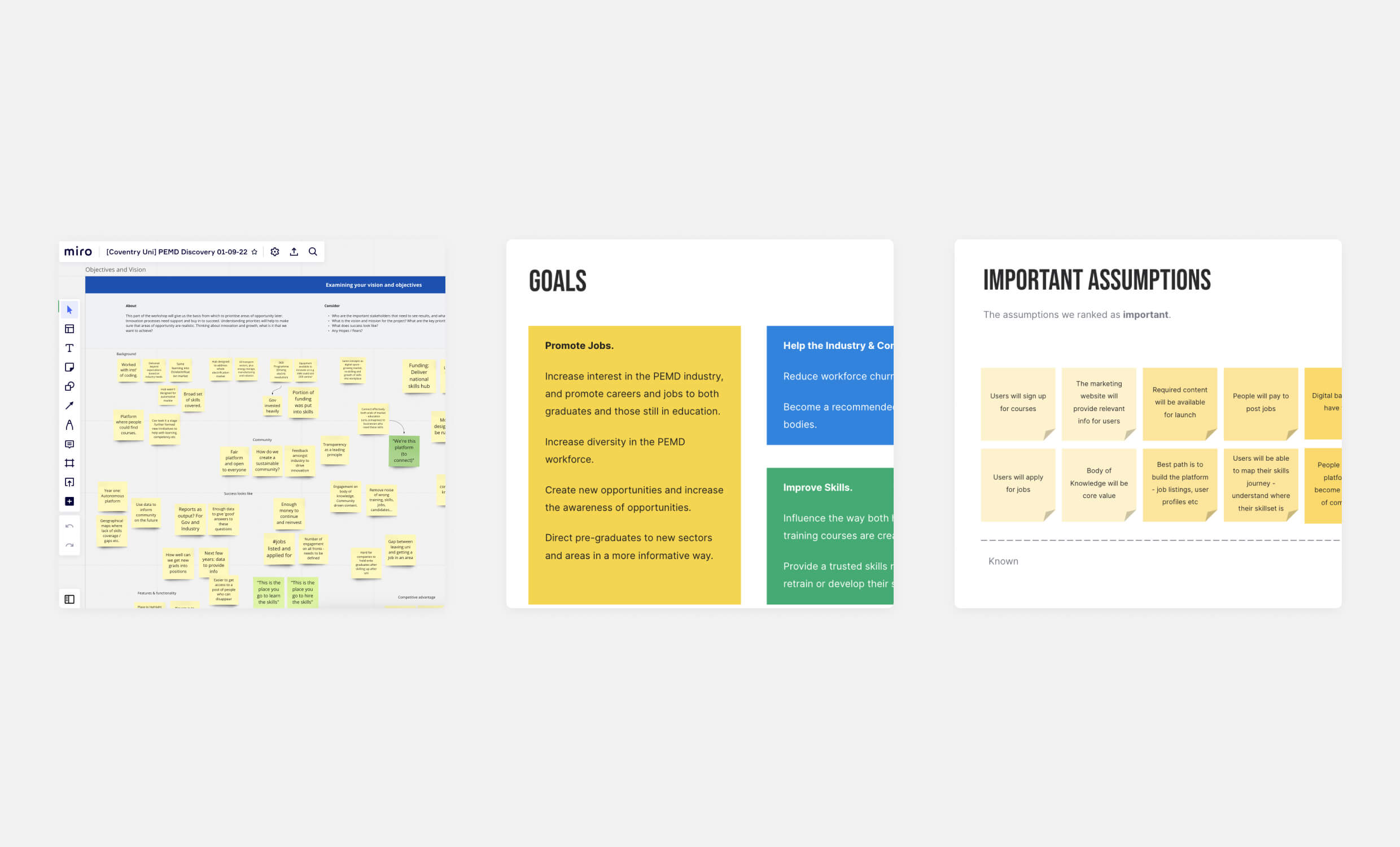
Discovery workshops surfaced user goals and key assumptions. I synthesised this into design priorities that shaped product direction and platform structure.
Key Insights from Discovery:
- Skills standardisation was critical: Without a common language for PEMD competencies, employers couldn’t articulate needs and training providers couldn’t align curricula
- Trust and authority were essential: Users needed confidence that this was the authoritative national resource, not another startup attempting to enter the space
- Network effects would drive success: Value would compound as more training providers attracted more learners, creating a larger talent pool that attracted more employers
Competitive Research & Market Analysis
I conducted comprehensive analysis across job boards, educational platforms, and marketplace models to understand user expectations and industry standards. This research spanned generalist platforms like Indeed and LinkedIn, specialised technical job boards, university course directories, and successful multi-sided marketplaces.
Critical Findings:
- Search and filtering sophistication: Users expected advanced filtering capabilities that allowed precise matching of skills, locations, and opportunity types
- Trust signals and verification: Successful platforms invested heavily in verification badges, partner logos, and clear quality indicators
- Personalisation drives engagement: Self-assessment tools and personalised recommendations significantly improved user retention and platform stickiness
- Mobile-first was non-negotiable: Even B2B platforms needed seamless mobile experiences for busy professionals and students
This research directly informed our information architecture, establishing skills-based tagging as the core organising principle and prioritising search functionality as the primary user pathway.
Multi-User Journey Design
The platform’s complexity required designing interconnected experiences that created value for each user type while strengthening the overall network effect. I mapped comprehensive user journeys that balanced individual user needs with the platform’s strategic objectives.
For Individual Learners & Job Seekers:
- Skills assessment onboarding: Self-evaluation tool that personalised the platform experience from first visit
- Personalised discovery paths: Filtered course and job recommendations based on current skills, location, and career goals
- Progress tracking: Clear pathway visualisation showing how training opportunities connected to career advancement
For Employers & Recruiters:
- Targeted talent access: Direct connection to pre-qualified candidates through skills-based filtering
- Strategic intelligence services: Horizon-scanning and skills audit capabilities for workforce planning
- Training provider partnerships: Streamlined access to develop bespoke upskilling programs
For Training & Education Providers:
- Course promotion and discovery: Sophisticated tagging system ensuring courses reached relevant audiences
- Market intelligence access: Data on employer needs and skills gaps to inform curriculum development
- Integration with PEMDBoK: Direct alignment with industry standards to enhance course credibility

I led the development of the platform’s information architecture, mapping content structure and system flow to support a multi-sided marketplace.
Designing for Future Monetisation
Beyond the immediate launch requirements, I designed comprehensive user flows and interface concepts for future revenue streams. These included premium employer services, advanced analytics dashboards, certification and badging systems, and enhanced training provider promotional tools.
This forward-thinking approach ensured the platform architecture could evolve without fundamental redesign, providing Coventry University with a clear roadmap for sustainable long-term operation beyond initial UKRI funding.
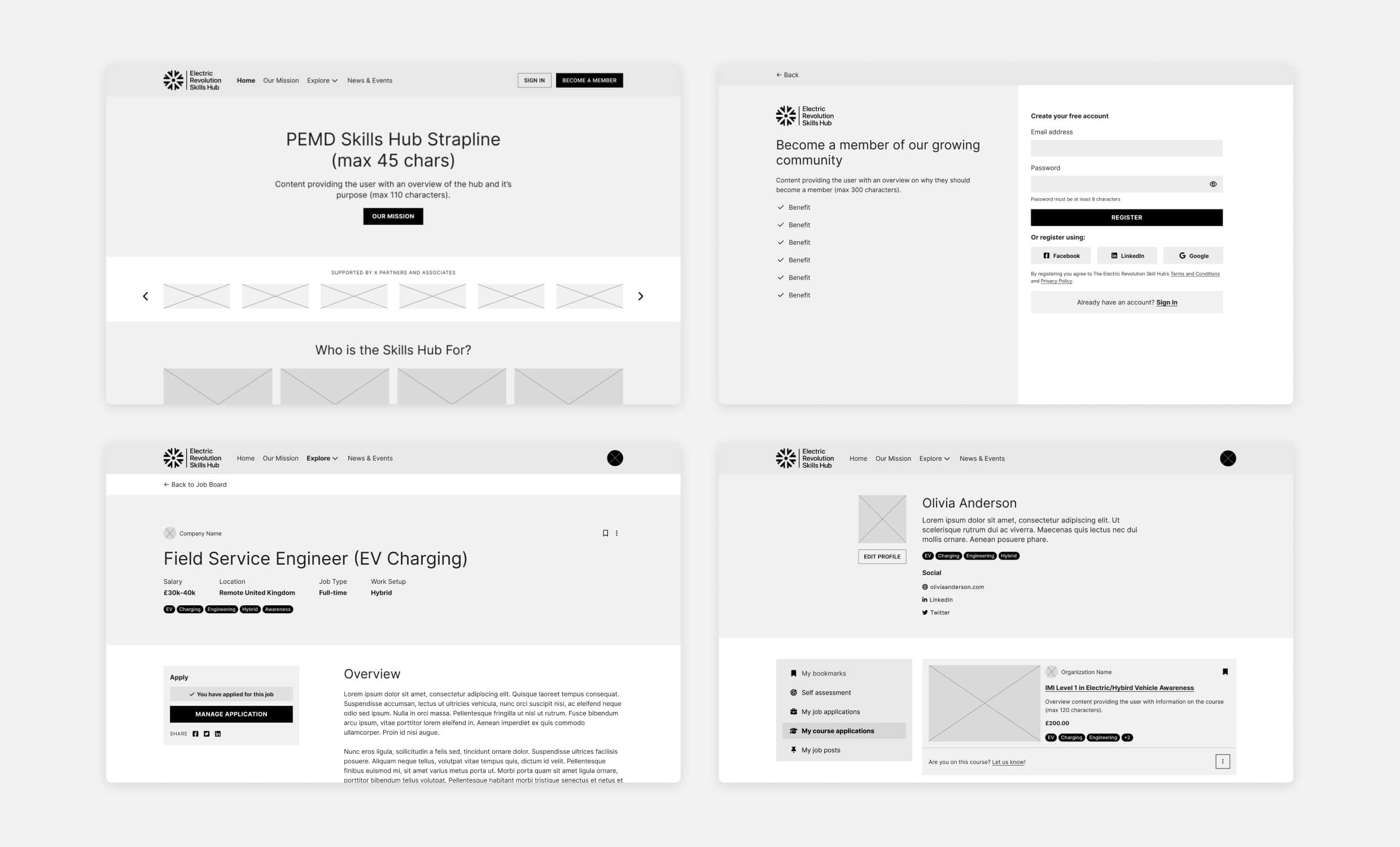
I developed early wireframes to define layout, content strategy, and key interactions before moving into high-fidelity UI design.
Visual Design & Brand Positioning
The visual design needed to establish immediate credibility while remaining accessible to diverse user groups. Working within Coventry University’s brand framework, I created an interface that balanced academic authority with modern usability expectations.
Key Design Decisions:
- Professional but approachable aesthetic: Clean, contemporary design that appealed to both students and senior industry executives
- Skills-first information hierarchy: Every page prioritised skills-based navigation and content discovery
- Trust and verification emphasis: Prominent display of partner university logos, official certifications, and quality indicators
- Accessibility as standard: Full WCAG compliance ensuring the platform served the broadest possible user base
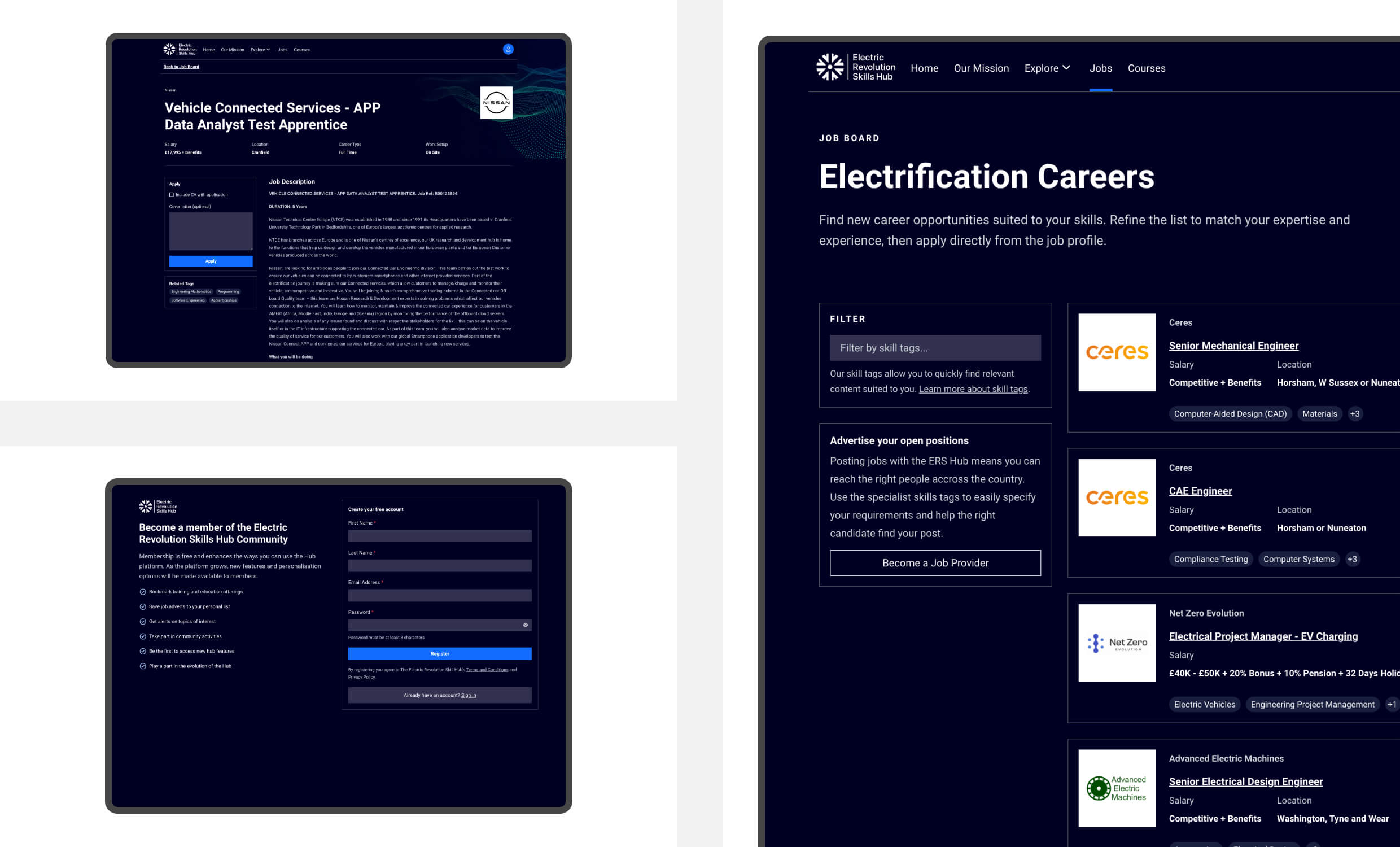
I designed the UI for the ERS Hub job board and registration flow to support personalised discovery and user engagement across learner and employer experiences.
The design system emphasised modularity and scalability, enabling rapid addition of new features and content types as the platform grew.
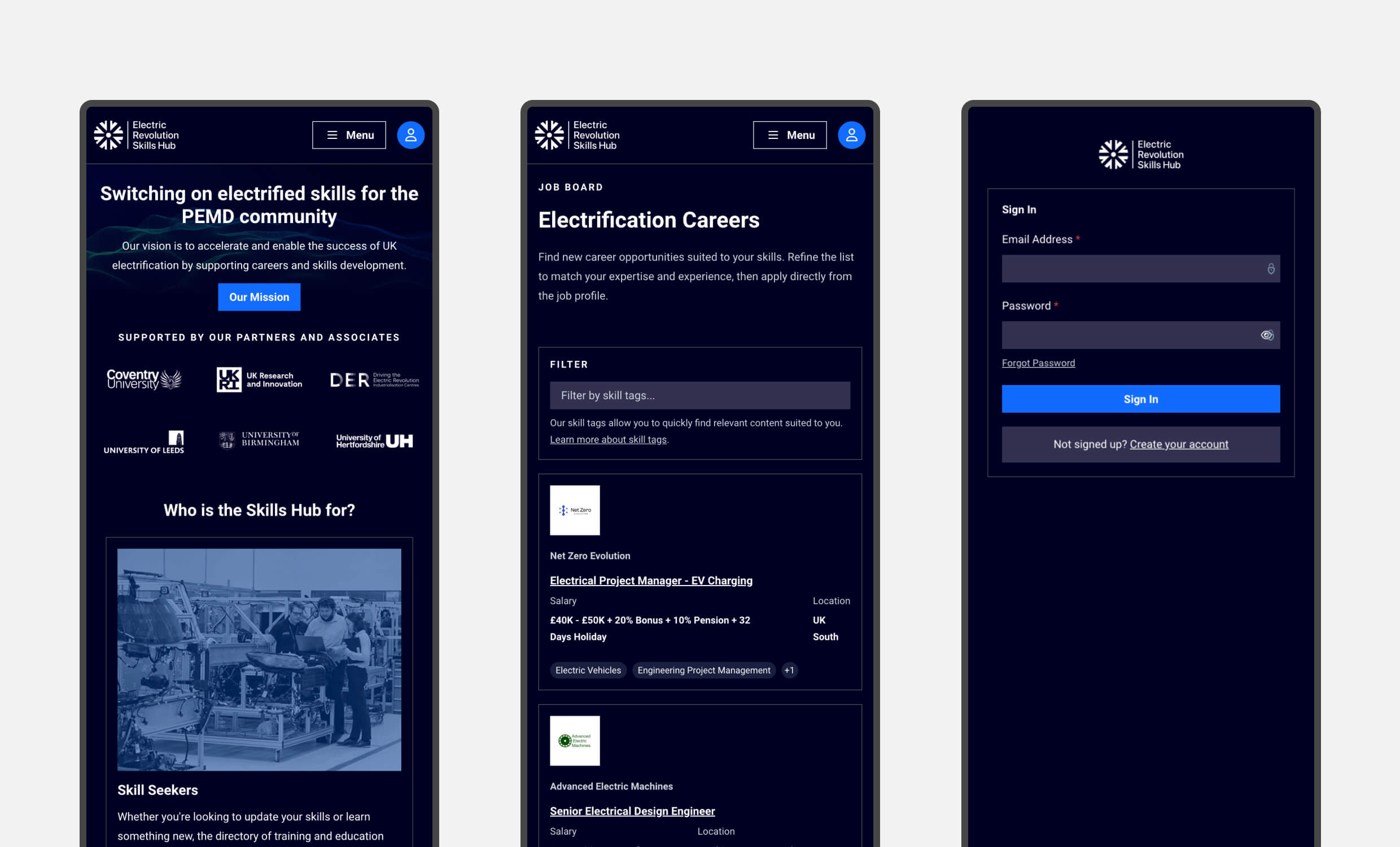
I designed responsive UI components for the job board, optimised for usability and consistency across desktop and mobile breakpoints.
Launch & Knowledge Transfer
I presented the design strategy at the national launch event at Birmingham’s International Convention Centre, speaking to hundreds of delegates about the importance of accessibility and human-centred design in building trust within technical communities. The presentation emphasised how thoughtful design could make the electrification sector more attractive to diverse talent, directly supporting the platform’s mission to expand the skills pipeline.
Comprehensive Team Transition:
- Detailed design system documentation: Complete component library with usage guidelines and interaction specifications
- User journey maps and flow documentation: Clear guidance for future feature development and optimisation
- Strategic rationale for all major decisions: Ensuring the team understood not just what was designed, but why specific approaches were chosen
This thorough handoff enabled junior designers to confidently continue the platform’s development, maintaining design quality and strategic alignment as new features were added.
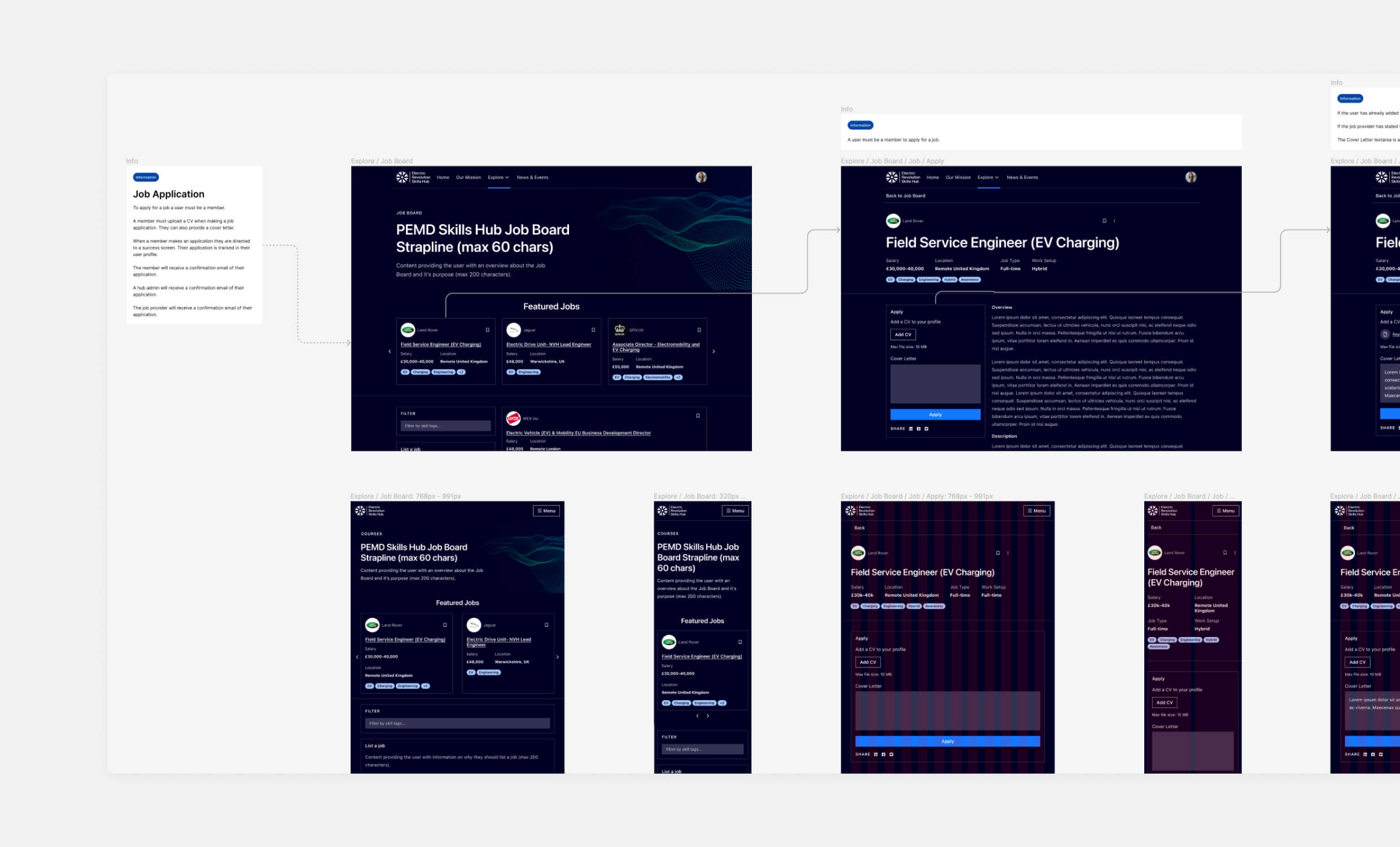
I documented every design decision in a scalable system handoff that supported future development, onboarding, and feature growth.
Outcome & Impact
The Electric Revolution Skills Hub successfully launched as the UK’s definitive platform for electrification skills and careers. Major universities including Newcastle, Queen’s, Cardiff, Leeds, and Manchester joined as founding partners, alongside national organisations like IET, UKRI, and BCMIO.
Platform Performance:
- Immediate institutional adoption: Launch partnerships with leading UK universities and technical organisations established credibility and content volume from day one
- Sustainable growth trajectory: Platform now hosts hundreds of jobs and training courses, demonstrating successful network effects
- National standard-setting: PEMDBoK established as the authoritative skills framework for the UK electrification sector
- Strategic foundation: Comprehensive design system and monetisation framework positioned for long-term sustainability
Key Design Insights
Multi-sided marketplaces require network orchestration, not just interface design. Success came from understanding that each user group’s engagement strengthened value for others, requiring careful design of interconnected experiences rather than separate user portals.
Authority and trust are designed, not assumed. In a crowded digital landscape, establishing credibility required deliberate visual and functional design decisions that communicated official status and institutional backing.
Skills standardisation becomes competitive advantage. By creating the definitive skills framework for the sector, the platform didn’t just list opportunities, it defined them, making it essential infrastructure for the entire industry.
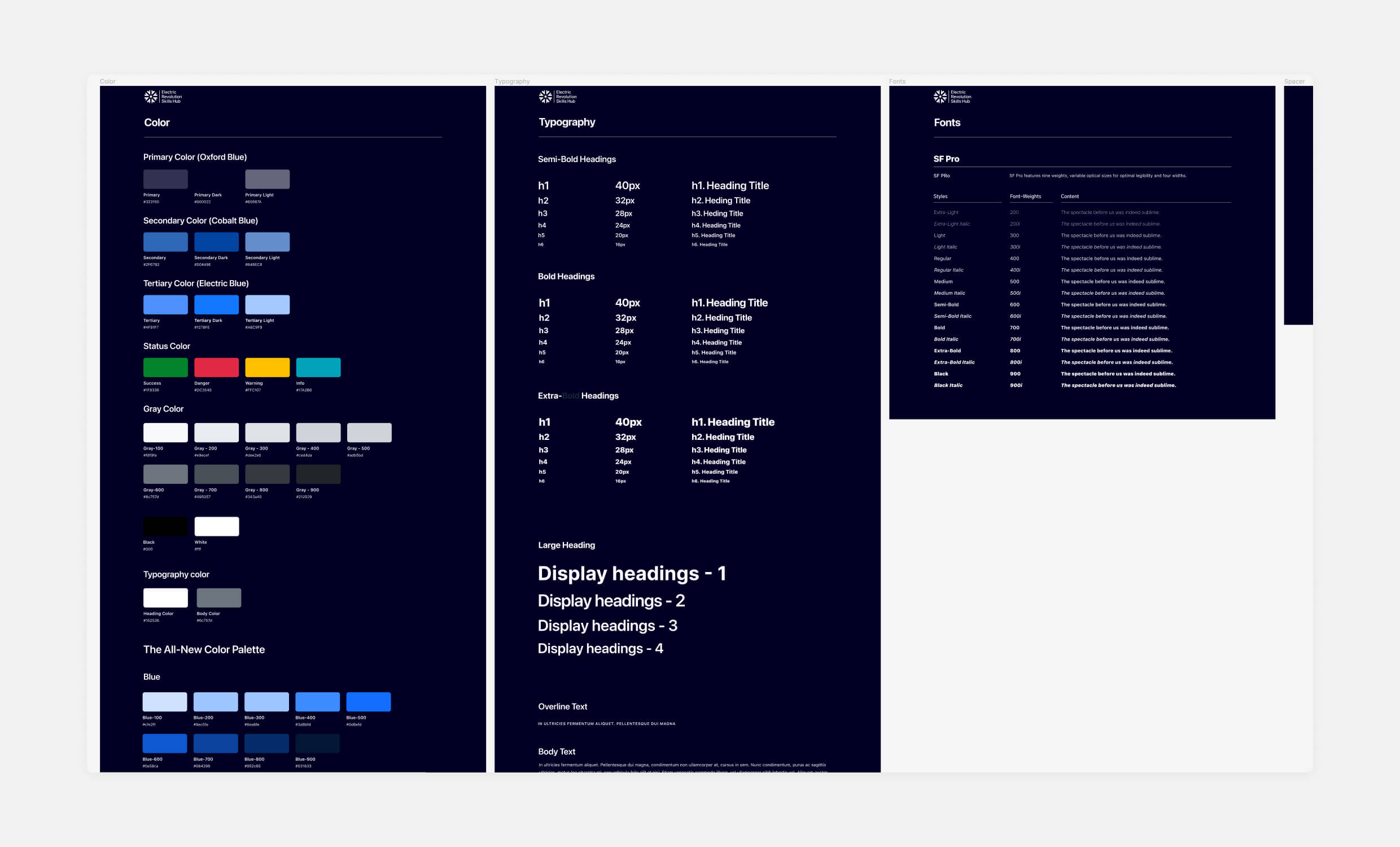
I created the visual design system including colour palette, typography, and spacing rules to establish brand credibility and support consistent UI execution.
Personal Takeaways
This project demonstrated how strategic design thinking can enable national policy objectives. Working within a compressed timeline while designing for multiple complex user needs required constant prioritisation and stakeholder alignment, but the result was a platform that genuinely served its community rather than just its immediate users.
The experience of presenting design decisions to a national audience reinforced how thoughtful UX work directly impacts policy outcomes. When design successfully removes barriers and creates inclusive experiences, it becomes a tool for social and economic change, not just user satisfaction.
Most significantly, this project showed me the importance of designing for transition and growth. The comprehensive documentation and strategic framework I created enabled the platform to continue evolving successfully after my involvement, demonstrating that great design work creates lasting institutional capability, not just immediate deliverables.








